
June 2008
Part Two
Isla Gambina, Mallorca
and Isla Cabrera
Baleric Islands, Spain
| |
| HOME |
| About Tenaya |
| About Us |
| Latest Update |
| Logs from Current Year |
| Logs from Previous Years |
| Katie's View |
| Route Map |
| Links |
| Contact Us |
![]()
June 16, 2008
We have had a some beautiful days and nights in anchorages. Diving off the stern, swimming and snorkeling in clear, refreshing water and exploring the nearby land has filled our time.
After leaving Palma we sailed east along the southern coast of Mallorca looking for a nice anchorage to spend a few days. Another yachtie called us on the radio to warn us the wind was expected to increase. We opted for the safety of Pureto de la Rapita. After one night and a 70 euro charge for our alongside berth we moved to the bay just outside the marina. We were able to get the marinas high speed wifi at anchor, a nice bonus. We prefer being at anchor to marinas where we are packed in close to other boats. This month the Mallorcan marinas are beginning to fill with charter boats. Most are Bavarias with 6 - 8 German men aboard. They are all having fun often times singing loudly. It's a big difference being on a week-long sailing holiday and living aboard!

Tenaya anchored at Isla Gambina
Two days later we moved to nearby Isla Gambina, just south of Playa del Trench, one of Mallorca's finest beaches. The water felt great on our hot skin and we had a great time snorkeling around the little island and along the rocky shore.
This area is popular with naturists so there were quite a few tan, pink and red bodies on the beach and in the water. That was all the reason we needed to leave the swimsuits in their locker and swim unconfined.

Isla Gambina and anchorage
We anchored just off the beach in about 4 meters on sand. We could see the bottom perfectly and watch the fish swim by. We even saw a starfish on the sand beneath the boat.
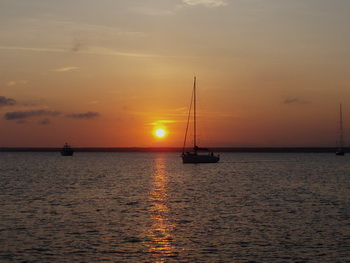
Sunset in Isla Gambina anchorage
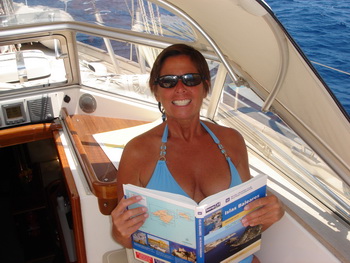
Choosing locations for our next stops
June 15, 2008
We had reservations at Cabrera Island for 2 nights. This virtually uninhabited national park lies 11 miles south of Mallorca. Anchoring overnight anywhere around the islands is prohibited and only 50 boats per night are allowed in the anchorage of Puerto de Cabrera on the northwest side of the island. Mooring balls are provided to limit impact and protect the neptune grass (posidonia oceanica). Movement on the island and on the water is restricted to to protect the rare species of plants and marine life. No tourist resorts or jet skis here, only a few other boat people, including some singing Germans, and a natural environment. The perfect place for us!
The impressive sight of a castle built high on the rocks greeted us as we entered the bay between peaks towering above the narrow entrance of the bay.

Tenaya moored at Cabrera Island in the shadow of a 14th century castle.
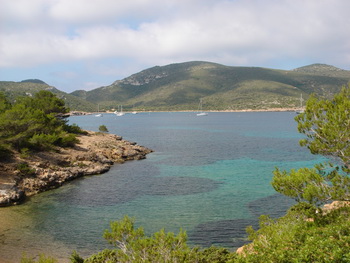
Once inside, the bay opens up wide in a spectacular location surrounded by hills dense in native wild olive, juniper and pine. The dry mediterranean vegetation includes more than 460 species on the island, 30 of which are unique to Cabrera.
Our first day included a walk up to the castle and lots of swimming and relaxing.
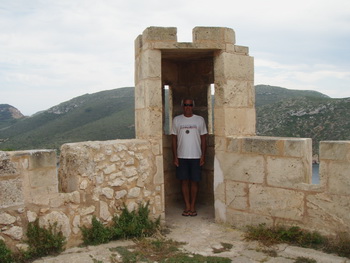
Jim standing guard at the castle

Katie descending to the ground floor
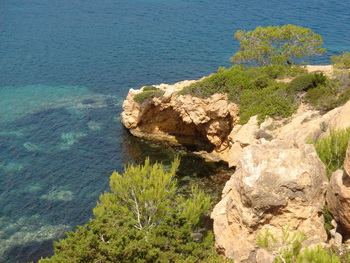
Rocks topped with native scrub above crystal clear water

Native pines along the shore

Another view of the anchorage and island
We were a bit more adventurous on our second day at Cabrera Island. With permission we hiked to the lighthouse at the southwestern tip of the island.
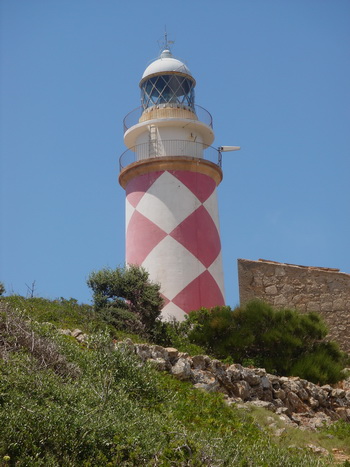
Lighthouse at Pta. Anciola
The well maintained path wound between the hills and was shaded in parts by the endemic foliage. Walking about 4 miles took us to the other side of the island. We were rewarded with the fragrant aroma of rosemary carried on the wind up the steep hillside as we neared the lighthouse. Wild rosemary grows all over this side of the island. How I wanted to pinch a few sprigs to spice up our dinner but touching the plants was not allowed. I stopped several times to immerse my nose in the bushes and take in all the delicious scent I could.

The path out to the lighthouse wound up and down and between the hills
.

Wild rosemary grows all over Isla Cabrera
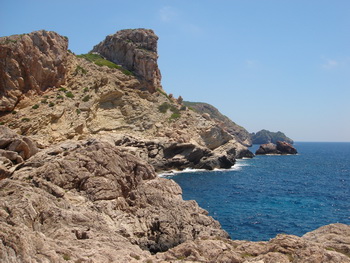
The spectacularly rugged southern shore of Isla Cabrera consists of steep cliffs and many islets
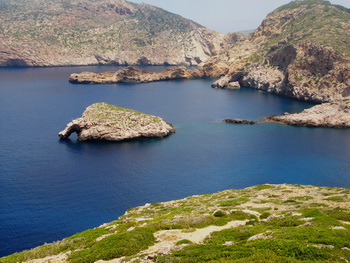
Bothering the wildlife is not allowed so I couldn't revert to my childhood habits and try to capture one of the many lizards on the island. The green and black lizards, endemic on Cabrera, slithered across our path countless times.

June 17, 2008
We left the beautiful island of Cabrera in the morning and motored to Cala Gran on Mallorca. The pilot book says it is a large, safe cala. We were the first boat to arrive and anchored in 5 meters over sand.
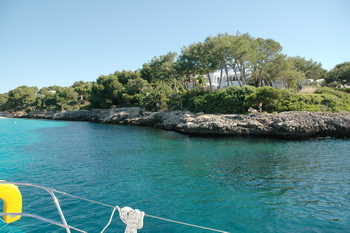
As soon as we were settled I pulled out my snorkeling gear and hopped off the stern. The cool, clear water was exactly where I wanted to be. Eventually I kicked over the anchor and saw that we had dragged. Alerting Jim I stayed in the water while he put Tenaya in reverse to set the anchor. It still dragged through the soft sand. I stopped him before plowing into the neptune grass. He hauled it up and tried again in another patch of sand letting out 30 meters. It held fast so he rolled 10 meters back in.
As we maneuvered another sailing yacht arrived and plopped down its anchor. When we were set I kicked over to alert them of the soft sand. I offered to check their hold while the skipper pulled in reverse. His anchor held fast as he was set in the neptune grass.
Soon another sailboat arrived but by now Jim and I were snorkeling along the rocky shoreline so this skipper was left to fend for himself.

A nice beach and a few hotels are at the head of Cala Gran. Beautiful homes line its edges.
A bit later an enormous 75 foot powerboat entered the cala. It seemed to take up the entire width of the entrance as it approached. Surely it would see there wasn't enough room and leave. Nope. It maneuvered around a bit over at the far side from us and then began letting out chain. The other yachts were very close and words were exchanged. The crewman opened the storage at the stern, lowered the swim platform and lowered the dinghy into the water. He took a line to shore and secured the behemoth. Apparently too close for the third yacht, the small boat fired up his engine and left.
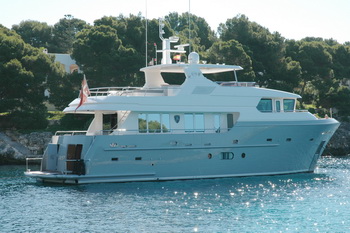
This huge yacht dwarfed the three sailboats already in the anchorage, chasing one away.
It seemed plausible we would touch him if we swung 180 degrees so set out a second anchor from the bow. Jim rowed the fortress out in the dinghy then pulled the rode in tight while I watched to see it set.
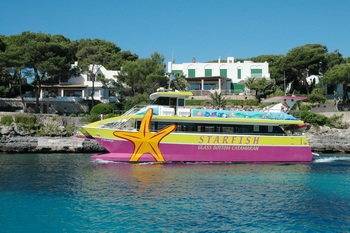
Ferries passed by Tenaya closely so at times we were sandwiched between two big, tall boats.
The following day we had a lovely sail to Porto Cristo, halfway up the east coast of Mallorca. The wind was directly aft so we were able to sail wing and wing for many miles.
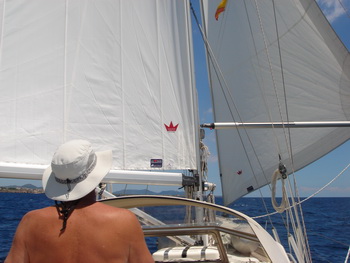
Porto Cristo is a small, busy town whose main claim to fame are two nearby caves. We visited Cuevas del Drach, an excellent example of the word cavernous. Carved out of limestone it is one of the largest of more than 200 caves on the island and includes one of the world's largest underground lakes. We walked for 20 minutes along a path taking in the spectacular sights of millions of illuminated stalactites and stalagmites. Some were small and some were huge, many in between. Occasionally some branched out horizontally. How is that possible? Those reflected in the lake were the most gorgeous. Caves with lakes have excellent acoustics and we were treated to a short concert by musicians floating by in boats. At the end we had the option to climb in one of the boats and be rowed to the exit. We climbed on board. It was the only way I could taste the water to see if it was salty or sweet. Touristy, yes, but still a special experience. Cameras were not allowed but to view pictures go to www.cuevasdeldrach.com.
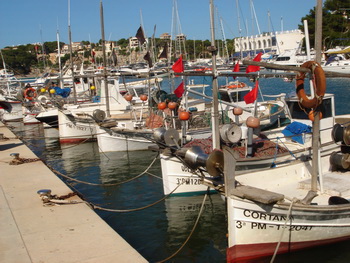
Fishing boats at Porto Cristo
Puerto de Pollensa is a logical place to cross the 60 miles to Menorca. Located at the head of a beautiful wide bay it is surrounded by spectacular mountains. There is a nice marina at the yacht club where we tied up to the wall in the center of town. We would have preferred to lie on one of the moorings in the bay but we were expecting the Spectra watermaker repairman again. We're beginning to feel like Mark is an old friend. He replaced the salinity probe again and will send us a new programmed circuit board. Maybe that will be the answer since this fourth salinity probe failed after the first use.
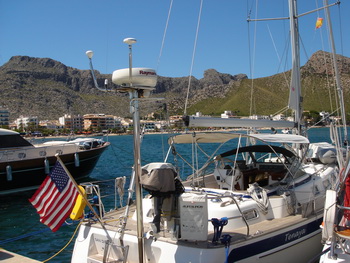
Puerto de Pollensa
After Mark's visit we hightailed it out of the marina and hooked a mooring ball at nearby Isla de Formentor. It is a protected cala within the larger Bahia de Pollensa. Beautiful water and gorgeous scenery made for a wonderful afternoon and evening. We snorkeled over to the island and crept along the edge over the neptune grass and shallow sandy bottom spotting fish we hadn't seen before. Jim pointed out a red starfish and another tan one moving along the sand. The following morning we left for Minorca.
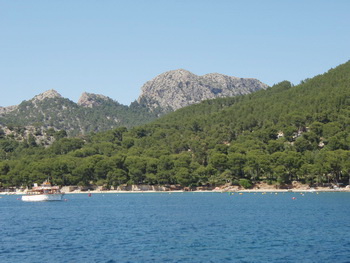
The anchorage at Isla de Formentor
Find Isla de Cabrera on Google Earth
.